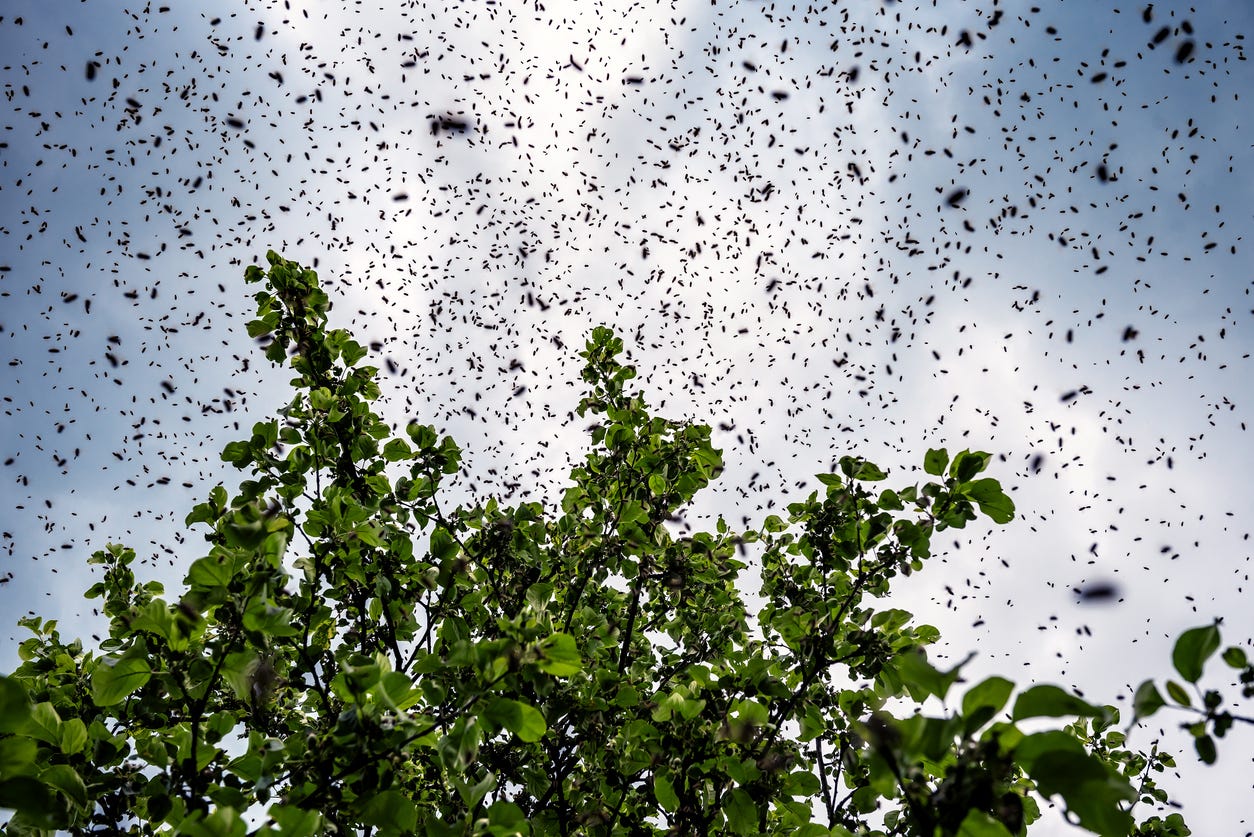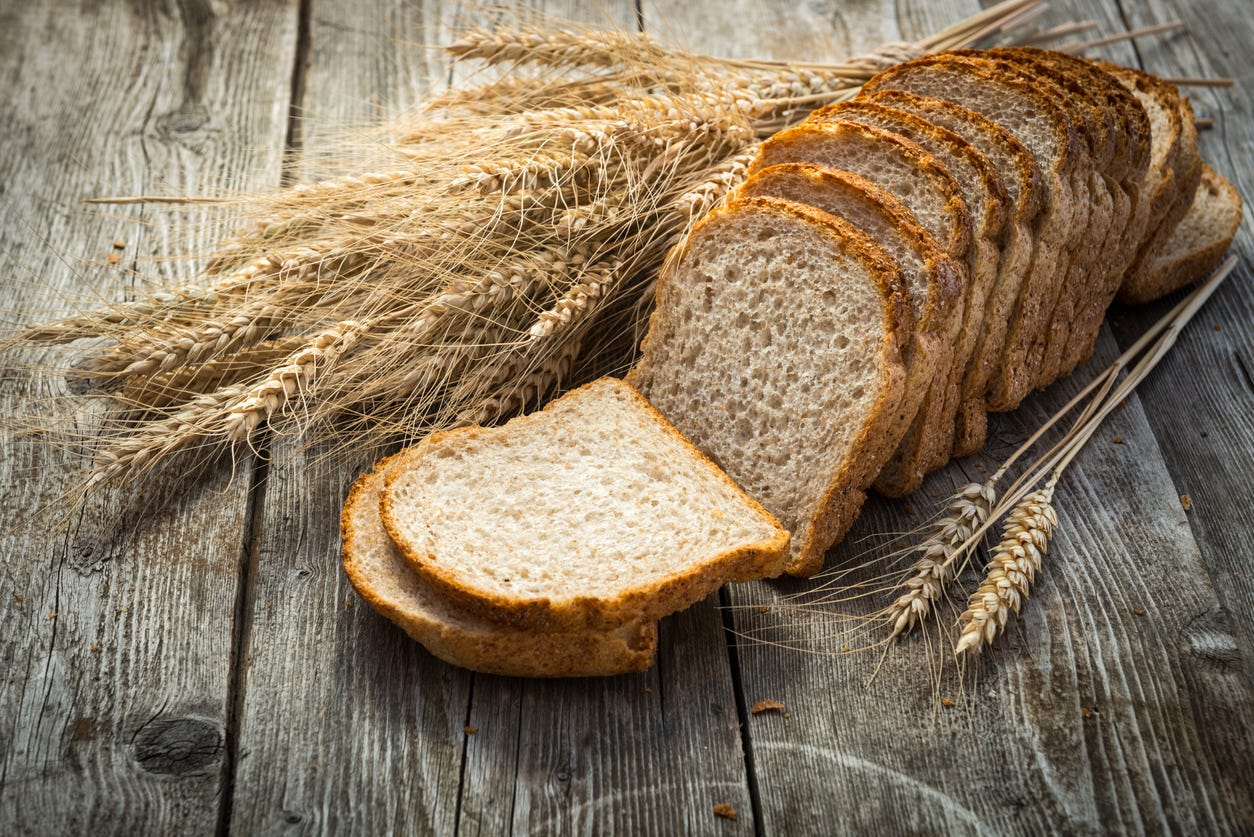Fairy Tale Truths: The Giant Jam Sandwich
A tale of summer strawberries, fruitful cooperation and one enormous loaf of bread.
Each month, I write a short summary and explanation of a story, connecting it to both the symbol of the month as well as to faith. I break it down using the Four Senses of the Middle Ages - the Literal Sense, and the three Spiritual Senses: the allegorical, the moral and the anagogical or eschatological. Although the Four Senses are typically used to understand Scripture, they are also helpful in reading any piece of literature. Since the symbol for July is sweet, summer strawberries, I chose a story about wasps, community and one giant strawberry jam sandwich.
What do you do when four million wasps suddenly descend upon your small town, one hot summer day? Do you run and hide away at home, waiting until the onslaught has passed? Do you try to take on the wasps by yourself, swinging and swatting at them individually? Or do you join with the rest of the town, your neighbors, family and friends, in working to come up with a solution together?
This is the scenario described in the fictional children’s book The Giant Jam Sandwich,1 by John Vernon Lord and Janet Burroway. First published in 1972 and later republished by Houghton Mifflin Company Boston, as part of the Weekly Reader Children’s Book Club, The Giant Jam Sandwich gives a delightful and inspirational answer to the insect infestation encountered by the small village of Itching Down. It is written in rhyming verses, and fully illustrated with color pictures. Here’s the story broken down according to the Four Senses.
1. Literal Sense: What does the story say?
One day, for no apparent reason, four million wasps descend upon the small town of Itching Down, which is located down the way, across a small river, nestled amongst soft green hills. The wasps simply overwhelm everyone, no matter what they are doing. They interrupt the summer picnickers. They drive Farmer Seed out of his field as he’s cutting the hay. They even manage to get inside, into the huge home of Lord Swell and the halls of the Mayor’s Office. They are everywhere, and they interrupt everything. From recreation to work to home life, no activity is safe from these stinging, driving, hungry wasps.
Desperate, the villagers call a town meeting to come up with a solution. Bap the Baker2 jumps to his feet, offering a wild idea. He proposes that the townspeople make a giant sandwich, spread it thick with strawberry jam, and trap all those pesky wasps within it. The idea is met with approval, and everyone gets busy.
Under Bap’s instructions, an enormous loaf of bread is prepared from scratch. The loaf is mixed, rises, and is then baked in a huge brick oven converted especially for the occasion. The enormous loaf bakes for hours and hours. Meanwhile outside, another group of villagers busily sews a giant tablecloth to lay the sandwich on. Finally, the bread is ready. They cut two big slices, load them onto specially designed wagons, and head out to meet the wasps.
One slice is laid out on the giant tablecloth, while the other hovers up in the sky, attached to “six flying machines”3 including Farmer Seed’s tractor (with a bunch of helium balloons attached so it can fly). Trucks drive up with loads of butter and then the strawberry jam follows. Both are liberally and properly applied to the slice of bread. The trap is laid. Everyone waits and watches.
Finally, in come the wasps, down drops the bread, and up go the cheers of celebration! We are told that “only three got away,” so the villagers’ plan has worked. They are rid of the noisy, nasty wasps, and they even give the local birds a tasty meal to boot. The last illustration shows a bunch of birds carrying the giant jam sandwich, still wrapped in the gingham tablecloth, flying off into the sunset where they “had a feast for a hundred weeks.” The villagers dance and celebrate, and everyone is happy.
2, Spiritual Sense A - Allegorical: What does the story mean?
The first thing to notice about the symbolic meaning of this story is the wasps themselves. They seem to work as a swarm, getting into every single aspect of life in Itching Down, causing confusion, irritation, and widespread mayhem. They interrupt all parts of normal human life, especially life lived in community. They drive the picnickers away from their rest, disrupting leisure and re-creation. They force Farmer Seed to stop working, pushing him out of his field where he is harvesting hay, the crop of summer grass that is gathered to feed the animals during winter. They invade the homes of the wealthy with land, meaning that position, tradition and titles are of no avail. Likewise, they infiltrate the halls of government, the mayor’s office. This opening tells us that there is no one who is safe or exempt from the descent of the wasps. They have interrupted work, rest, home life and public life. They are everywhere and in everything.
In the old days, the wasps would have been identified as evil spirits, plain and simple. Today, we might call them impurities, distractions, annoyances or even the noon day devil. But whatever name they might go by these days, they are certainly around and in everything, just as the story points out. We’ll just call the wasps by a group name - “sin.”4 If the wasps represent sin, what traps and gets rid of them? Bread and Fruit of the Vine!
The story hinges around the making, baking, and breaking of the enormous loaf of bread, that is then paired with the fruit, the strawberry jam. This particular loaf of bread is made from wheat, which has a specific meaning, brought forward from the Jewish feast days. According to Rabbi Shlomo Yaffe,5 wheat is associated with the Jewish Pentecost festival, or Shavuot, the day when sheaves of wheat were presented to God in thanksgiving for the harvest. (Barley ripens first and is associated with Passover.) Shavuot takes place 50 days after Passover, hence the name Pentecost, for 50. Bringing this understanding forward, in Christianity barley is associated with Passover, and the self-offering of Christ and the Last Supper, but wheat is connected to Pentecost, and the descent of the Holy Spirit, which took place 50 days after Easter. In the Jewish tradition, Shavuot celebrates the giving of the Law to Moses, so that the people could live in right relationship to God. We are likewise empowered at Pentecost to live as followers of Christ through receiving the Holy Spirit, shown in the response of the apostles in the Upper Room. At our worship table in the Mass, we break bread with the Eucharist, made from unleavened wheat flour and water. We drink the fruit of the vine, grapes crushed and made into wine, the Body and Blood of the Lord made present through the power of the Holy Spirit.
The bread and jam in the story are an approximation, a reminder of our Eucharist. In fact, every meal is a participation in the Eucharist. But there are some differences between the story and the Mass. The hosts at Mass, although made of wheat, must be free from yeast, unleavened, so they do not rise like the enormous bread in the story. Likewise, the fruit of the vine in The Giant Jam Sandwich is made from crushing strawberries, not grapes. There’s a whole theology around why grapes and wine are necessary for our Eucharist, and I’m not suggesting we start substituting fruits. The important thing to remember from this story is not so much the specifics of the bread and jam, but our need to work together in the vocations God has given us to overcome sin. This communion is only possible with the actual Eucharist, because we need the Holy Spirit. We can’t do it on our own.
3. Spiritual Sense B - Moral: How does the story teach us to act?
It’s the response of the villagers that really stands out. They quickly recognize that they can’t get rid of the wasps alone, individually. They gather together to brainstorm ideas in a big town hall meeting. Shopkeepers sit next to aristocrats. Farmers chat with elected officials. Not only is everyone part of the conversation, but everyone also realizes there is a problem in their little town. This problem can’t be ignored. It must be addressed, and everyone has to do their part in overcoming it.
This is a great image of the church. In gathering together, we understand that we all have a common problem, and this problem is in our homes, our schools, our offices, our shops and everywhere else, including our hearts. In short, the problem and presence of sin is just like the wasps - everywhere, in everything and everyone. To rid themselves of the wasps, the villagers understand that there is only one idea that can work, and it involves a whole lot of wheat bread.
Under the guidance of Bap the Baker, they get to work. Somehow, enough flour, salt, yeast and water appear to form this huge loaf of bread. The people who make the bread listen to Bap’s instructions, so that bread is made well. Other people, bricklayers, architects and engineers, convert an old brick building into a usable oven. Others who are good with their hands create the giant tablecloth, churn the butter and make the truckloads of strawberry jam. In other words, the unique skills and talents of every person are used properly, to help others as much as themselves. The work is sacrificial and becomes purifying, instead of self-serving, seeking to build oneself up.
Making the giant loaf is an image of building the kingdom of God, one of the primary tasks of the Church. When people turn their insides and outsides, i.e. their thoughts and their actions (seen in their work), over to building the Kingdom of God, amazing things happen. Abundance shows up. Food is multiplied. Communities are able to work together peacefully, turning away from violence and pettiness, growing into fruitfulness and generosity. We see this in the story when, having baked this amazing loaf of bread and created all the necessary butter and jam to spread on it, the villagers realize that “the village bus, they all agreed, would spoil the fields of Farmer Seed.” Despite having a pressing problem, they nevertheless pause, noticing that pushing their plan through as it was originally conceived will be harmful. So, they take the time to reassess. Imagine that! During a time of significant crisis, they are calm and reflective, not simply reactive, acting in the name of unbridled progress. They adjust the plan. They hitch up “eight fine horses” to the wagon, and the bread is moved out to the picnic cloth.
The story centers around the bread and the jam, which will work together to trap the wasps and bring relief to the people, as images of the bread and wine, the work of human hands consecrated to God, which deliver and purify us from sin. As the Catechism reminds us “As bodily nourishment restores lost strength, so the Eucharist strengthens our charity, which tends to be weakened in daily life; and this living charity wipes away venial sins. By giving himself to us Christ revives our love and enables us to break our disordered attachments to creatures and root ourselves in him.” (CCC 1394) Through participation in the sacramental life of the Church, receiving the bread and wine, we are able to overcome sin and become Christlike ourselves, serving as he did.
4. Spiritual Sense C - Anagogical or Eschatological Sense: How does the story point us forward, to our end?
The story ends by saying that those nasty wasps “never came back to Itching Down, which is not a waspish sort of town.”6 And how could it be? Once the town throws off the chains of sin, the wasps also have to disappear. The villagers dance and play, showing their joy and celebration, just as though they are at a huge feast - a wedding feast, perhaps? As mentioned above, the huge birds disposed of the wasps trapped inside the sandwich. They flew it off, far away, never to be seen again, where they feasted for “a hundred weeks.”7 We might even say that’s Pentecost doubled.
So, to sum it all up, The Giant Jam Sandwich reminds us of our need to participate in a community, especially our parish community, with the people who gather to eat at the Lord’s Table, addressing the problem of sin and partaking of its remedy. The amount of participation varies depending on the season of life; not everyone is called to do the same thing at the same time. But everyone can do something. The story also reminds us of our need for the Eucharist to overcome sin, all those wasps that are constantly pushing us off course. Lastly, it tells us that we are called to use or own specific skills and talents to purify ourselves and help others, that our work has meaning beyond what we do day to day.
Put another way: Community + Eucharist + Work = Freedom + Celebration (Heaven)
The book is available on Amazon, where you can take a look inside at the first few pages. Also, I need to let you know that this is an affiliate link. If you purchase the book after clicking this link, I receive a small commission and you’ll get a wonderful book!
This is a cute play on words, since a bap is a specific type of small bread roll, often used for sandwiches.
The Giant Jam Sandwich
Sin is “humanity’s rejection of God and opposition to him…It is an abuse of the freedom that God gives to created persons so that they are capable of loving him and loving one another.” (CCC 386-387)
From Barley to Wheat - Chabad.org
The Giant Jam Sandwich
In stories, birds are almost always symbols of angelic beings, as messengers of God who can move between the earth and the skies.










This sounds like such a good book! We have had a good share of wasps this year!!